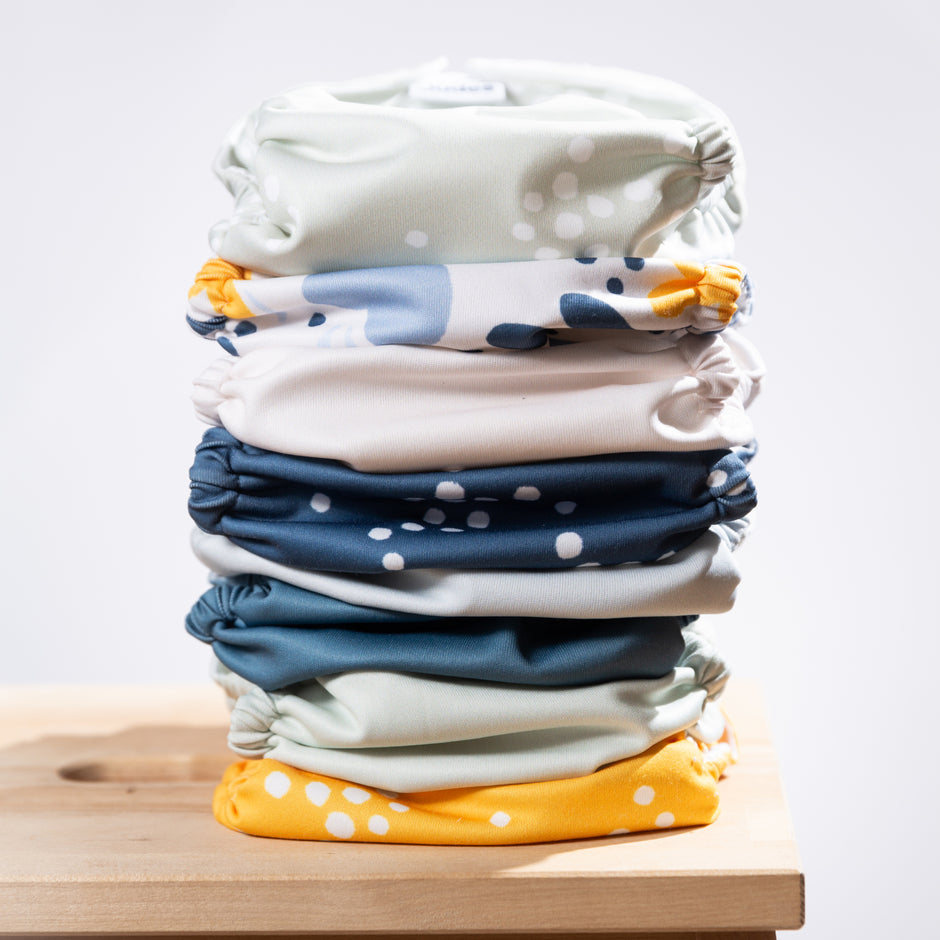How Many Diapers Does a Baby Need Per Day? Find Out Here!
Updated on:
As new parents, you quickly get used to changing diapers. But how many diapers does a newborn actually need? And how often should you change them? In this article, I delve into these questions to help you better understand what to expect in the first weeks and months with your new arrival.
How many diapers do babies need per day?
On average, newborns need 8-10 diapers per day. This means that you will need to change your newborn's diapers 8 to 10 times in a 24-hour period. Of course, every baby is different, and some may need to be changed more or less frequently than others. It's also important to know that this number increases as your baby grows and begins to eat solid foods. However, as they age, the number will decrease again.
How often does a baby have bowel movements?
Newborns first excrete meconium. This stool is greenish to black. After that, your (healthy) child's stool will be more yellowish to ochre-colored.
The frequency of bowel movements varies from child to child. This also depends on how your baby is fed. Is it exclusively breastfed or does it receive formula? For breastfed babies, there is the rule of thumb "Five times a day or once every five days!". My daughter, as an exclusively breastfed baby, sometimes went 10 days without a bowel movement (which the pediatrician considered harmless). Once your baby starts eating solid foods, the color, consistency, and frequency of bowel movements changes.
Therefore, no one can predict how many diapers (with bowel movements) your baby will have per day.
How many wet diapers do babies have per day?
Your newborn should urinate for the first time within the first 24 hours of their life. In breastfed infants, there are not as many wet diapers before the milk comes in. After that, it is approximately 7 wet diapers per day (see here). A diaper is considered wet with about 6 tablespoons of liquid.

How many diapers do babies need in the first week?
In your baby's first week of life, you can expect to need about 60 diapers: 7 wet diapers per day amount to about 50 diapers in a week. In addition, there are diapers with bowel movements. This number gradually decreases as your baby produces less waste and longer intervals between diaper changes pass. Exactly when the number of diapers decreases is hard to say, as it varies from child to child and depends on the baby's diet. By around 6 months, babies need only about 5 diapers a day.
How often should you change a baby's diapers?
Ideally, you should change your baby's diaper every 2-3 hours or as needed. This applies to both disposable diapers and cloth diapers. This approach prevents diaper rash and ensures your baby's comfort. It is, however, important to listen to your baby's cues and change the diaper more frequently if they seem uncomfortable or produce more waste than usual.
How often should you change the diaper when the baby is sick?
When your child is sick, their waste output may change. For example, with diarrhea, you will need to change your child's diaper significantly more often. Your baby may also need more fluids, resulting in more wet diapers. This also increases diaper usage. It's best to pay attention to your child's signs.
Signs that your baby needs a diaper change
There are several signs that can help you determine when it’s time to change your baby’s diaper. These include:
-
your baby is restless or crying
-
your baby's diaper is wet
-
your baby's diaper smells of stool
-
your baby makes specific sounds or words before they need to go
-
Gestures and facial expressions from your baby, such as eye contact, whining, stretching, or pushing
Additionally, many children have individual elimination times that repeat (e.g., after feeding or sleeping). If you notice one or more of these signs, it is time to change your baby’s diaper. As parents, you often recognize a pattern in the timing of your newborn's eliminations shortly after birth. These patterns can change over time, but can continue to be recognized and observed.

How to diaper with Judes - a guide
The goal of Judes is to be the simplest cloth diaper in the world. And this claim sets Judes apart from other cloth diapers. Judes do not cater to the usual prejudices of cloth diapers. They are health beneficial for your child and stand out for their sustainability.
More and more parents are diapering their children with Judes. That's why our guide is based on Judes cloth diapers.
Changing a diaper of a newborn might seem intimidating at first, but it is actually quite easy. Here are the steps you should follow:
-
Gather everything you need, including a clean diaper, wipes, and a changing pad or towel.
-
Lay your baby on their back on the changing pad or towel.
-
Open the used diaper and remove it from your baby.
-
You can easily dispose of the stool using the Judes Poo Papers.
(Breast milk stool does not require a Poo Paper as it is water-soluble and can be easily washed out). -
Place the used inner diaper in the diaper bag and the outer cover can be hung up to air out if it is clean.
-
Clean your baby's bottom with warm water and Judes washcloths or a washcloth.
-
Place the clean inner diaper under your baby and fasten the Velcro. (If necessary, insert a Poo Paper first)
-
Now place a clean outer cover under your baby and fasten the Velcro here as well.
-
The used diapers go into the Judes diaper bag, which, once it's full, goes into the washing machine along with the diapers.

What type of diapers is best for a baby?
There are many different types of diapers on the market. Ultimately, you as a parent will decide which diapers you want to use. I can help you with your decision by providing information.
I also recommend reading our articles on the sustainability of cloth diapers compared to disposable diapers and the health benefits of cloth diapers to aid in your decision-making process.
Disposable diapers
Conventional disposable diapers consist mainly of plastic. They contain a chemical core (superabsorbent) that is supposed to keep the diaper always dry. You can find a list of the ingredients at the German Environment Agency.
Disposable diapers belong in the residual waste. In the EU alone, an estimated 33 billion disposable diapers are consumed per year, resulting in approximately 6.7 million tons of waste annually, according to the United Nations Environment Programme.
Besides the sustainability concerns, disposable diapers are also quite costly. You can expect to spend about €2,995 over 3 years of diapering. That's why Judes cloth diapers are also cheaper than disposable diapers.
Eco-diapers
Unlike conventional disposable diapers, eco-diapers are made mostly from compostable materials. Instead of regular plastic, bioplastic is used. Studies show, however, that bioplastics also contain chemicals, just like conventional plastics. The absorbent core in most eco-diapers consists of the same superabsorbent used in conventional disposable diapers.
Even though the partially compostable contents might suggest otherwise, eco-diapers also belong solely in residual waste. Therefore, the amount of waste does not change by choosing eco-diapers. The costs for eco-diapers are, however, higher than for other disposable diapers.
Cloth diapers
There are many different types of cloth diapers. Their advantage over disposable diapers: they are made from natural materials. In our experience report, you can read about the differences between Judes and other cloth diaper systems. I'll only tell you about Judes here.
Judes diapers aim to be the simplest cloth diapers in the world. The startup wants to offer a sustainable diaper with Judes that is as easy to use as disposable diapers. They consist of an outer cover (made of 100% recycled polyester) and an inner diaper (made of organic cotton), which can be put on just like a disposable diaper.
To catch your baby's bowel movements and make removal easier for you, Judes Family has developed its own Poo Paper (made of paper). The stool is simply discarded with the Poo Paper, just like with disposable diapers. For the night, you only need to insert a booster pad into the diaper, and it will stay leak-proof all night. For "heavy wetters" (as was the case with us), we recommend using two booster pads for the night.
With Judes, you buy only 2 sizes and that suffices from birth to potty training. Disposable diapers of all kinds offer significantly more sizes. This leads to leftover diapers, resulting in even more waste. Cloth diapers are definitely more sustainable, and they are also financially preferable to disposable diapers. Don't believe it? Then read up on why disposable diapers can be a financial trap.
Used Cloth Diapers
When cloth diapers are no longer needed, parents often sell them. However, when purchasing second-hand diapers, special attention must be paid to quality.

Photo by @kerstinbrigitteposch
Conclusion
On average, you will change about 8-10 diapers per day in the first year, and around 5-8 times per day from the age of one year, but this also depends on the individual needs of the baby. As a general rule: Pay attention to your baby's signals and change the diaper as often as needed.
It is important to change your newborn's diapers frequently to prevent diaper rash and ensure your child feels comfortable.
Frequently Asked Questions
Question: My baby seems to need diaper changes more often than other babies I know. Is that normal?
Answer: Every baby is different, and some need their diaper changed more frequently than others. If you are changing your baby's diaper every 2 to 3 hours and they are still crying or fussing, it's okay to change it more often.
Question: My baby currently has red skin on their bottom. What could be causing this?
Answer: Redness in the diaper area can have various causes. Some reasons might include teething or the introduction of solid foods. If there are intolerances, your child's skin may react. This can occur with foods as well as with detergents. Additionally, many children react to the ingredients in disposable diapers. Other reasons for a red bottom may include wearing the diaper for too long or diaper rash. You can find a detailed article on diaper rash here.
Tips for New Parents
-
Make sure you have everything you need for the diaper change within reach before you start. This includes a clean diaper, wipes, and a changing pad or towel. You can find more on this in our 8 Tips for Perfect Changing Table Equipment.
-
Pay attention to your baby's signals and change the diaper as often as necessary, even if it's more frequently than average.
-
Store used Judes in the diaper bag until they are washed.
-
Breast milk stains can be removed by placing them in the sun.
How were your first days with the baby? Feel free to share with us in the comments.
You can find even more tips on our Instagram account.

